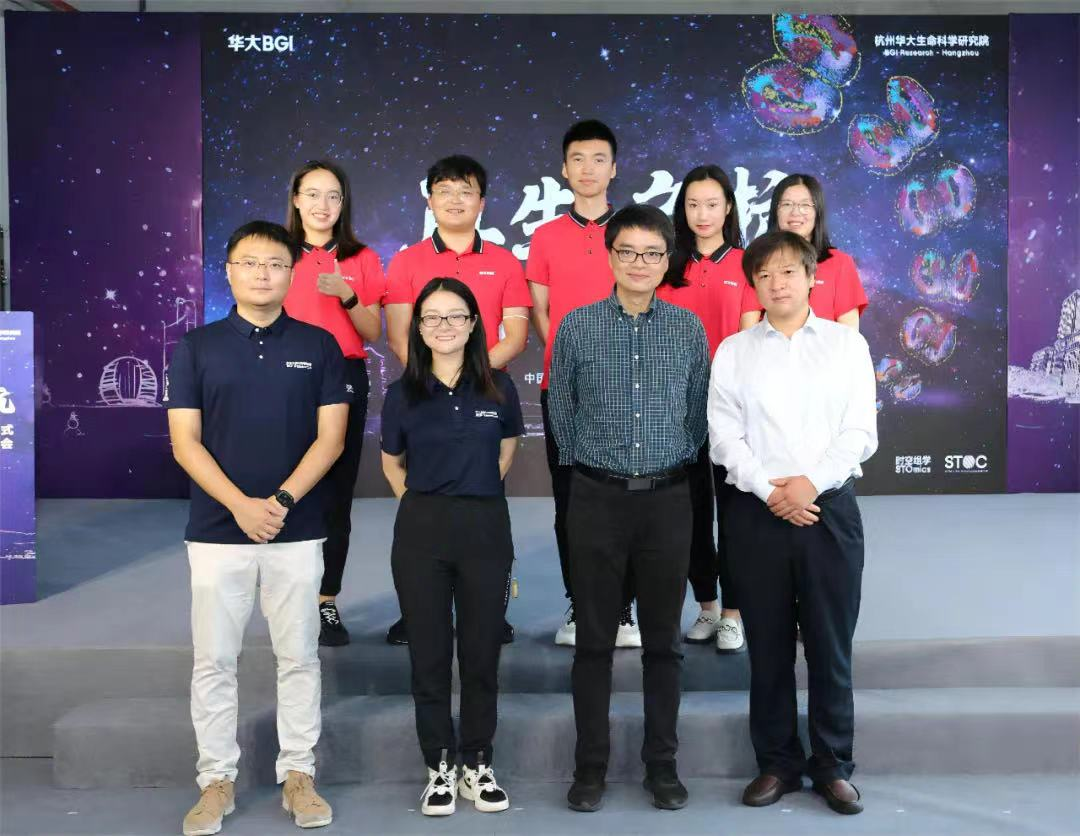On September 2, the world’s first spatiotemporal cellular atlas of brain regeneration was published in the top international journal Science. In just six months (Mar 22 to Sep 2, 2022), BGI's scientific studies using Stereo-seq and single-cell technologies have been published four times in the three leading journals Cell, Nature and Science - a “Grand Slam” for the global science community.
These accomplishments would not have been achieved without the efforts of researchers. Today, we have an opportunity to learn about their journey with the axolotl research.
 September 2, (front row from left) Li Hanbo, Gu Ying, Chen Liang, Fei Jifeng and (first from left in the back row) Wei Xiaoyu at the press conference of axolotl research publication.
September 2, (front row from left) Li Hanbo, Gu Ying, Chen Liang, Fei Jifeng and (first from left in the back row) Wei Xiaoyu at the press conference of axolotl research publication.
Core research team member of this study:
The co-first authors of the research paper are Wei Xiaoyu, Fu Sulei, Li Hanbo, Liu Yang, Wang Shuai, Feng Weimin, Yang Yunzhi. And the co-corresponding authors of the paper are Gu Ying, Fei Jifeng, Xu Xun, Chen Liang and Li Hanbo.
Q: Why did you choose salamanders as the research subject of the world’s first spatiotemporal cellular atlas of brain regeneration? What changes will this research bring to the research on mammalian nervous system?
A: Li Hanbo (co-corresponding author, researcher at BGI-Research)
The salamander is a tetrapod vertebrate. From the perspective of evolution and structure, it sits at a relatively high evolutionary position among species with strong regeneration abilities. The structure of the salamander's body and organs is highly similar to that of mammals. In addition, multiple organs of the salamander, including the brain tissue, have comprehensive cell regeneration abilities to rebuild the tissue structure after severe injury. It is a perfect model animal for regeneration research, and therefore we chose the salamander as the research subject.
Moreover, we have a long-term in-depth cooperation with Professor Fei Jifeng’s team. Professor Fei is an expert and a pioneer in the research of salamander regeneration in China. By studying salamanders, we can fully leverage Mr. Fei's team and their experience.
For the second question, in the past, research on regeneration of the nervous system lacked systematic studies on the spatiotemporal regulation of gene expression. Most of the studies were based on simple cell type lineage tracing - how one type of cell transforms into another in the process of damage repair or regeneration. Our research focuses on the processes of development and regeneration. From both dimensions of time and space, we were able to digitally demonstrate the dynamic changes of each cell type of the telencephalon, the corresponding transcriptome, and the interaction between cells.
Q: As a senior expert in the field of brain science and rehabilitation medicine, what role do you think the emergence of spatiotemporal omics technology has played in the overall progress of your research work? What research content that was difficult to carry out in the past has been realized through spatiotemporal omics technology?
A: Fei Jifeng (co-corresponding author, professor at Guangdong Provincial People's Hospital)
BGI's Stereo-seq spatiotemporal omics technology plays a very important role in this research. Before the advent of spatiotemporal omics technology, single-cell technology was generally used. Single-cell technology has many advantages, but after each cell is dissociated, it loses its original spatial location information. Spatiotemporal omics technology makes up for this shortcoming. By using spatiotemporal omics technology, we have realized in situ observation and analysis of the dynamic changes of key stem cells that are involved in regeneration near the injury site as part of the process of brain regeneration in salamanders.
In this research article on salamander brain regeneration, our laboratory is mainly responsible for the construction of animal models of salamander brain injury, the collection and analysis of brain injury regeneration samples, and the further experimental verification of the results of bioinformatics analysis. BGI is responsible for Stereo-seq technology and related bioinformatics analysis. Therefore, our two research teams were complementary and combined the latest spatiotemporal omics technology to analyze the molecular and cellular state changes in the process of salamander brain regeneration. The result published this time is a good start. We and BGI are still cooperating in several other research directions, hoping to use new technologies to deeply analyze important scientific issues in the field of regeneration.
Q: How long did the research team take to complete this study? What difficulties have you encountered?
A: Wei Xiaoyu (first author, researcher at BGI-Research)
Our research started in February last year, and it took one and a half years from sample collection, data output, analysis to submission and publication of articles. Based on the platform advantages of BGI, we can make large-scale data production and analysis in a short time. The submission and review process went very smoothly.
The difficulty encountered in this project was the output of data. Because this is the first time spatiotemporal omics experiments have been conducted on the salamander species, the best experimental conditions for aquatic organisms was not known. Therefore, it took a certain amount of time to explore the test conditions in the early stage. Another difficulty is data analysis. Salamanders have a huge genome, so the amount of sequencing and data analysis resources required are also enormous. With BGI's high-throughput sequencing platform and Stereo-seq automated analysis platform, we could obtain sequencing data in a short time. And with the advantages of high resolution Stereo-seq technology, we were able to develop a cell segmentation algorithm in spatiotemporal omics, which enabled our project to analyze the important biological process of salamander brain regeneration at the single-cell level.
Q: This study was completed by 18 research teams from 3 countries. As one of the participants, what opportunities do you think brought these teams together to collaborate? What impressed you during the collaboration?
A: Chen Liang (co-corresponding author, professor at Wuhan University)
This is a very good question. I think the most important reason is BGI’s successful development of high-resolution Stereo-seq technology, which has enabled researchers to have a new tool to better understand the brain regeneration mechanism, a key scientific issue in the field of regeneration. Our multiple teams united closely, complementing each other's strengths, and exploring technical and scientific problems in depth.
There are many memorable things, and it is exciting to discover new scientific discoveries. At the same time, the interpretation of new types of data also required us to constantly re-examine our thinking. The new changes and experiences are impressive, and helped promote the exchange of scientific research ideas among team members, inspiring their efforts. I believe the emergence of Stereo-seq technology is going to have a profound impact on the research paradigms for many researchers.
Q: Based on the Stereo-seq technology independently developed by BGI, what other research are being carried out apart from this one?
A: Gu Ying (co-corresponding author, Vice President of BGI-Research)
In the field of regeneration, in addition to the research on brain regeneration using Stereo-seq technology, we are conducting research on other organs of salamanders, such as the spinal cord and limbs. Through the research of multiple organs, we hope to find out some common regulatory mechanisms and system response mechanisms of salamander regeneration. Aside from salamanders, we are also carrying out regeneration-related research on other species, such as planarians and fishes, and comparing the regeneration mechanism with mice and even primates, hoping to find out why damage repair ability has gradually declined in the evolutionary process. We also hope in the future to discover mechanisms that can improve the damage repair ability of mammals and even humans.
Apart from the research on regeneration, we also use spatiotemporal omics to conduct research in plant-related directions, including plant development and physiology, as well as some directions related to pest infestation.
Of course, what is most important is that in the study of diseases, whether it is for tumors, some cardiac diseases, or infectious diseases, we can apply Stereo-seq technology to the research of pathogenesis and intervention mechanisms, leading to discoveries to improve diagnosis and treatment.
Q: BGI has recently published multiple science research in top journals such as Cell, Nature, and Science. Could you please introduce the technical and talent support behind this?
A: Liu Longqi (Executive Dean of BGI-Research, Hangzhou)
The scientific research conducted by BGI-Research is “Big Goal” oriented and “Big Science” driven. Our ultimate goal is to realize “Omics for all”, which means using genomics technology for the wellbeing of mankind. In the process of reaching this goal, it is necessary not only to develop advanced technology, but also to realize its large-scale application. Mastering the core tools is particularly important, therefore, BGI attaches great importance to the R&D of underlying technologies. We have very strong capability in genomics technology research and the development high-throughput omics platforms. These will ensure that we can continue to develop new technologies and apply them quickly.
In the rapid development of the field, young talents are the key. We provide the opportunities to let young people undertake important projects, and they can grow and learn to become experts in their fields during this process.
Although many of our key members are young, they may have already accumulated extensive experience in organizing and promoting large projects and are serving leading roles in important projects.
BGI started with the Human Genome Project. We have always attached great importance to global cooperation. For many years, we have led or initiated many international scientific collaborations. For example, in May this year, we joined more than 125 scientific researchers from 25 countries to jointly launch the SpatioTemporal Omics Consortium (STOC) and published the first batch of research accomplishments in Cell. We see that in the current era of big science, cooperation among different international scientific research teams is becoming more and more vital.



